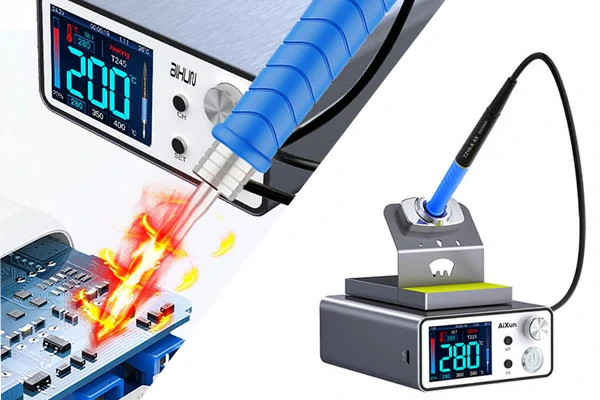
Soldering is an essential skill in the world of electronics, and when it comes to SMD (Surface Mount Device) soldering, precision and technique play a crucial role. SMD components have become increasingly prevalent in modern electronics due to their smaller size and higher component density. To master the art of SMD soldering, you need the right soldering station, along with a set of tips, tools, and techniques to make the process efficient and successful.

Before we delve into the world of soldering stations, let's first understand what SMD soldering entails. Surface Mount Device components are tiny electronic parts that are mounted directly onto the surface of a printed circuit board (PCB). Unlike through-hole components that have leads passing through the PCB, SMD components have no such leads. Instead, their connections are made by soldering directly to pads on the PCB.
SMD soldering offers several advantages, including space-saving, improved electrical performance, and reduced production costs. However, it also comes with its own set of challenges, primarily related to the small size of the components, precise placement, and the need for controlled heat during soldering.
The first step in successful SMD soldering is selecting the right soldering station. Here are some crucial factors to consider:
Temperature Control: Look for a soldering station with precise temperature control. SMD components require a specific temperature range for soldering, and the ability to set and maintain this temperature is essential.
Wattage: Consider the wattage of the soldering station. While higher wattage can heat up faster, it's crucial not to use excessive heat for delicate SMD work.
Ergonomics: Ensure that the soldering iron is comfortable to hold and use for extended periods, as SMD soldering can be intricate and time-consuming.
Digital vs. Analog: Some soldering stations come with digital temperature displays, offering more accurate control. Analog stations are simpler but may lack precision. Digital soldering station such as AiXun T3a, AiXun t3b ...
Quality and Durability: Invest in a high-quality soldering station. It's a long-term investment that will pay off in terms of reliability and performance.
Now that you have the right soldering station, let's take a look at the essential tools and materials you'll need for SMD soldering:
Soldering Iron: Choose a soldering iron with a fine, pointed tip for precise work.
Solder: Opt for high-quality solder with a diameter suitable for your components. Lead-free solder is a common choice due to environmental concerns.
Flux: Flux helps clean and prepare the surfaces to be soldered. It improves solder flow and reduces the risk of solder bridges.
Tweezers: Fine-tipped tweezers are essential for handling SMD components, especially during placement.
Magnifying Tools: Magnifying glasses or a magnifying lamp can greatly assist in seeing small details during soldering.
Desoldering Tools: Have desoldering wick or a desoldering pump on hand for corrections and repairs.
Now that you have all the necessary tools and materials, let's set up your soldering station:
Clean the Tip: Before use, clean the soldering iron's tip with a damp sponge or brass wire sponge to remove any oxidation.
Temperature Calibration: Set the temperature of your soldering station to the appropriate level for the SMD components you're working with. Refer to the datasheet or specifications for the correct temperature range.
Soldering Iron Stand: Use the soldering iron stand to keep the hot iron safely in place when not in use.
With your soldering station set up, it's time to explore some SMD soldering techniques:
Drag Soldering: In drag soldering, you apply a small amount of solder to one side of a row of SMD pads and then drag the iron along the row, allowing the solder to flow onto each pad.
Reflow Soldering: Reflow soldering involves applying solder paste to the SMD pads and then heating the entire PCB in a controlled manner to melt the solder and create connections.
Tack Soldering: Use tack soldering to temporarily hold an SMD component in place. Apply a small amount of solder to one pad, position the component, and then reflow the solder to secure it.
Hot Air Rework: Hot air rework stations are useful for removing and reworking SMD components. They use a stream of hot air to melt and reflow solder. Check out AiXun H310d Hot air rework station
Precision is key in SMD soldering. Here are some tips to help you achieve precise solder joints:
Steady Hands: Maintain a steady hand while soldering. Rest your elbows on the table for support.
Practice: Practice your soldering techniques on a scrap PCB before working on your actual project.
Inspect Your Work: Use a magnifying tool to inspect your solder joints for quality and potential defects.
Soldering Iron Maintenance: Regularly clean and tin the soldering iron's tip to ensure efficient heat transfer.
SMD soldering can present challenges, but with practice, you can overcome common issues like:
Solder Bridges: These occur when solder unintentionally connects two adjacent SMD pads. Use desoldering wick or a solder sucker to remove excess solder.
Cold Solder Joints: Cold solder joints result from insufficient heat or poor solder flow. Reheat and add solder to fix them.
While working with a soldering station, especially for SMD soldering, it's essential to consider safety:
Proper Ventilation: Work in a well-ventilated area to avoid inhaling fumes from the solder.
Eye Protection: Wear safety glasses or goggles to protect your eyes from splattering solder.
ESD Precautions: Use an ESD mat and wrist strap to protect sensitive components from electrostatic discharge.
As with any skill, practice is essential to mastering SMD soldering. Start with simple projects and gradually work your way up to more complex ones. Don't be discouraged by initial setbacks; soldering is an art that improves with time and experience.
In the world of electronics, SMD soldering is a valuable skill that opens up a world of possibilities. Whether you're building a prototype or repairing a device, having the right soldering station, tools, and techniques at your disposal can make all the difference. With the knowledge and guidance provided in this article, you're well on your way to becoming a proficient SMD soldering expert.
To further enhance your SMD soldering skills and knowledge, consider exploring the following resources: https://www.aixuntech.com/news/

Are you in pursuit of SMD soldering solutions that epitomize precision, reliability, and innovation? Look no further than AiXun, your premier partner in the realm of electronics manufacturing. As a trailblazer in the industry, AiXun has garnered a reputation for excellence that stands unrivaled. With a commitment to pushing the boundaries of technology and a relentless dedication to customer satisfaction, AiXun has solidified its position as the leading SMD soldering manufacturer in China. Welcome to visit or inquiry.
 WhatsApp
WhatsApp